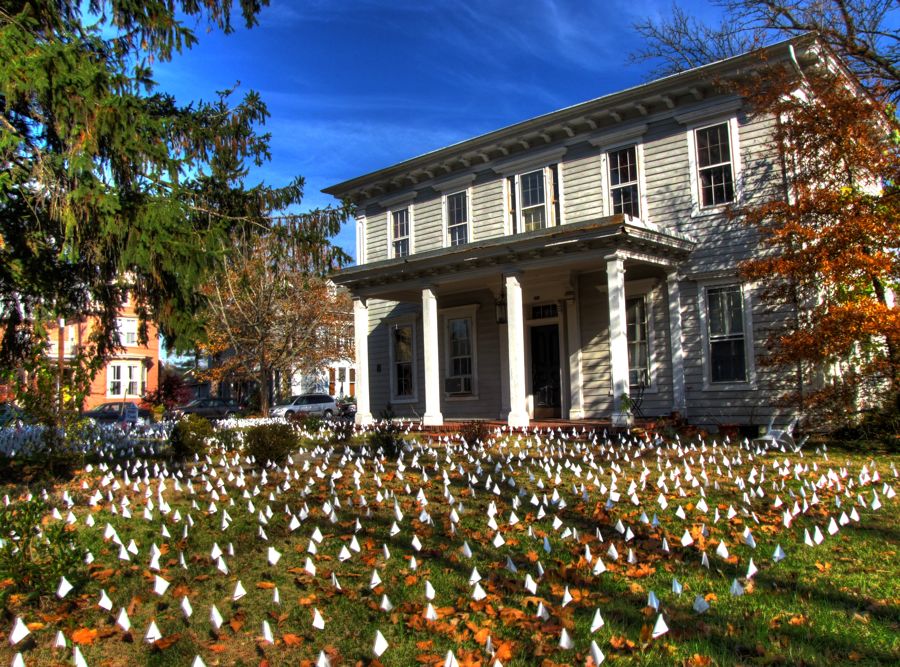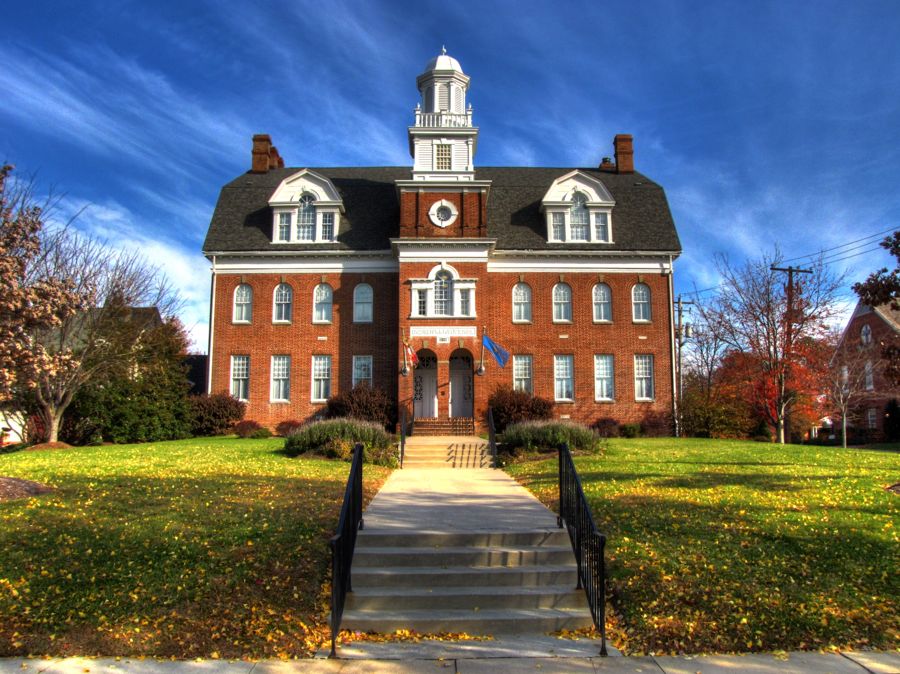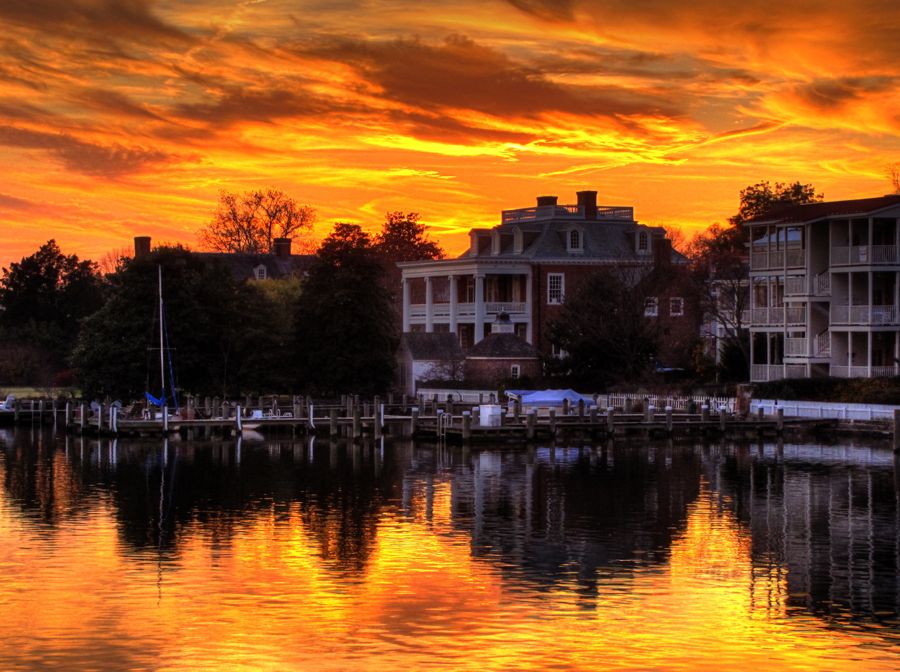After a lengthy layoff due to work pressures, I finally got back on the road in the trusty Z4 last weekend to seek out "scenic history" and the last of the Fall colors on the Eastern Shore of Maryland. The itinerary wasn't much—go to Chestertown, go to Eastern Neck Wildlife Refuge, go to Rock Hall, go back to Chestertown—but there was something interesting to see in each place and everywhere in-between.
Before arriving in Chestertown, however, I took a detour to discover what the town of Church Hill had to offer (such as an old church on a hill?) There
was one, and, in fact it proved to be one of the oldest brick churches in the state. St. Luke's was finished in 1732 and cost 140,000 pounds of tobacco. (Actual money wasn't all that common back then, it appears.) Services had started 40 years earlier in another church on the same site.

Chestertown, on the Chester River, was once the second-most-active port in Maryland, exceeded only by Annapolis. After its designation as one of the Royal Ports of Entry, it became a center of commerce and the primary port for shipping tobacco. Many of the townspeople became wealthy and built impressive mansions for their families, most of which still stand. (Uh, the mansions that is…) Chestertown was eventually eclipsed by the port of Baltimore, and today it's a sleepy-but-historic village that relies heavily on tourism, boating, and Washington College.
The White Swan Tavern has been welcoming visitors off and on since the mid-1700s. It started life as Joseph Nicholson's home and was expanded over the years to serve as a tavern. One of its subsequent owners was the Reverend William H. Wilmer, who was apparently able to reconcile his roles as a preacher and tavern owner and who later became president of William and Mary College in Williamsburg, VA. The tavern is now a bed and breakfast.

Colin Stam, the town merchant and druggist, built Stam's Hall in 1886.

Even the alleyways in Chestertown were scenic.

As I wandered around, I heard a live jazz band playing. It turned out to be the Kent County High School band, performing at the town square farmer's market to raise money for a trip to the Gator Bowl. They were quite good and had a heckuva rhythm section (drums, base, and guitar). I bought an excellent cinnamon roll from an Amish farmer and happily enjoyed both the concert and the snack.



The fanciest mansions were built right along the Chester River on (naturally) Water Street. They were all in excellent condition and were quite a sight.

Widehall was my favorite. It was built by Thomas Smythe in 1770, but it posed a problem for eager (and boatless) photographers, since there was no way to get a good vantage point without Serious and Obvious Trespassing. For example, the view from the driveway was blocked by this weeping willow.

In 1936, photographer E. H. Pickering appears to have had the same problem, although caused by a now-departed tree rather than the yet-to-be weeping willow. (Historic photos courtesy of the Library of Congress.)

I eventually resorted to a long-distance photo of Widehall, taken from the bridge over the Chester River. Mr. Pickering just walked onto the front yard.


Not only that, he apparently managed to talk his way inside Widehall, with the following results. Quite a place!


At the river's edge, a platoon of geese were guarding the waterfront—and seemed very serious about their duties.

Or were they guarding the ducks, who were lazily sleeping late in the shadows? Maybe they take turns?

Thomas Smythe also built River House, three doors down from Widehall. According to the Kent County Historical Association, it was the last of the great mansions built before Chestertown's decline as a port. River House dates to about 1785, by which time the Federal style was taking over from the Georgian style used for Widehall.

E. H. Pickering also turned his camera to River House, with these results. Note the inelegant Georgian entranceway, which was apparently a later addition and was changed back to the original style sometime after the 1960s.


Chestertown is also full of interesting non-mansions, including this colorful example…

…this one, with hundreds and hundreds of little flags in honor of servicemen who have died in the line of duty…

…this former parsonage for the Methodist church…

…and this 1877 residence, which is now a bed and breakfast.

With a last look at this former public school, it was time to move on to the Eastern Neck Wildlife Refuge.

Along the way, I came across numerous farms. This one appears to be both active (based on its fields) and abandoned (based on its buildings).

And speaking of abandoned buildings, this home is not long for the world. Although its former dignity and purpose are gone, there is still a sad beauty in its weathered texture and lost history.

While this part of Maryland certainly qualifies as the proverbial "middle of nowhere," not all of the buildings were abandoned and in ruins. St. Paul's Episcopal Church has operated continuously since about 1715. Its cemetery seemed to go on forever, and I later learned that it covers 19 acres. The oldest headstones dated to 1727, and the famously free-spirited actress Tallulah Bankhead (1902-1968) is buried here.



(By the way, if you think Britney, Paris, and Lindsey are out of control, check out Tallulah's fascinating story here:
http://en.wikipedia.org/wiki/Tallulah_Bankhead.)
The Eastern Neck Wildlife Refuge was easy to find, and it offered many scenic views (and an uncountable number of ducks and geese).


This little pine cone was only 1 1/2 inches long, but its scales were incredibly sharp. (When did
pinecones start developing defense mechanisms??)

There were dozens of bird watchers out and about, and some of them had spotted bald eagles. I'm still hoping to see one of these noble birds in the wild someday.


As I traveled on, Kent County seemed almost littered with abandoned houses. Behind more than one such house, there was an abandoned fishing boat as well.

Next up was Rock Hall, another historic town on the Eastern Shore. George Washington is known to have passed through here on at least 8 occasions, and for many years Rock Hall was the site of one of the Chesapeake Bay's largest shellfishing operations. When the Bay was largely fished out, the town began a long decline, which has been slowed only by an upsurge in recreational boating and an influx of retirees. This is Rock Hall harbor on the Chesapeake Bay.

Rock Hall has a small, eclectic museum that just happened to be open when I was passing by. It was open because the local Garden Club ladies were having a meeting there. (There were only three of them, and they all welcomed me like a long-lost brother.) The museum had all sorts of nifty items, including this relocated decoy carving workshop…

…an original Edison victrola…

…a restored "Fisherman" 1-cylinder marine engine that was "not pretty enough for yachts," but offered a "10-day free trial")…

…and this mysterious device. Care to take a guess?

After an excellent fried catfish sandwich from the Harbor Shack, it was time to head back to Chestertown and home. I ended up taking a very circuitous route, mostly because I was having a lot of fun and didn't want the trip to end. I took any road that had an interesting-sounding name, and most of them carried me even farther into the middle of nowhere. Inhabited houses were almost the exception. The uninhabited ones ranged from still salvageable…

…to barely standing. All of them evoked thoughts of years gone by and questions as to what happened to precipitate their decline.

At this low elevation, Fall colors were still evident, but, like the preceding house, their days are numbered.

Fortunately, Fall colors are just part of a cycle. Winter will come, to be followed by Spring, with its flowers, new buds, and new leaves. In this part of Maryland, Summer brings corn and other crops, which brings us back to Fall, harvested corn, and scenes like this one:

Once I stopped waxing moody and philosophical, I stumbled across this stately home with its unusual rooftop station (which I later learned is known as a "belvedere," from the Italian for "beautiful to view"). It overlooked the town of Melitota, and a sign on the gate indicated that this was Gobbler Hill. From subsequent "Internet research," I learned that it was built in 1858 by William Stephens, a prominent farmer, and is a rare example of the transition from the late Greek Revival to early Italianate style. It was renovated in 1988 and returned to its original configuration, based on early photographs and original drawings.

As the sun was starting to set, St. James Methodist Church suddenly appeared on the horizon, necessitating a photo stop. St. James was built some time after 1825 as a Protestant Episcopal church. In 1832, it was sold for $5.00 to the Methodists (who apparently know how to drive a hard bargain). After a slow start, the congregations grew, and the church has been quite active ever since.

I arrived back in Chestertown just as the sun was setting—which prompted a second trip on foot over the Chester River bridge to see if the sunset was photo-worthy. As it turned out, it most surely was!

Zooming in, here's one last picture of Widehall in a blaze of reflected sunlight.

Ah, the road home.

As these trips go, it was not one of the longest, and it didn't feature the most challenging roads for motorcycling or driving. But as a touring destination, it was hard to beat—there was history everywhere and fun places and things to discover around every corner.
Rick F.